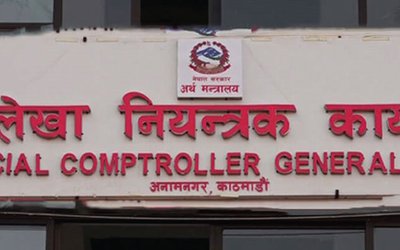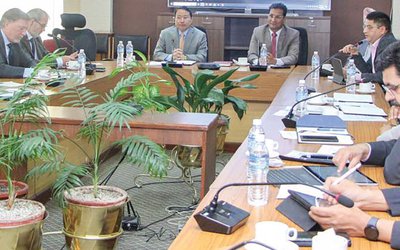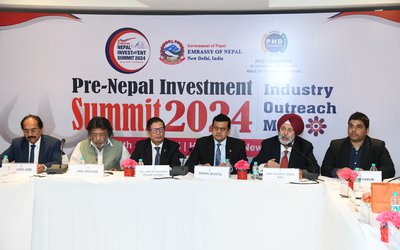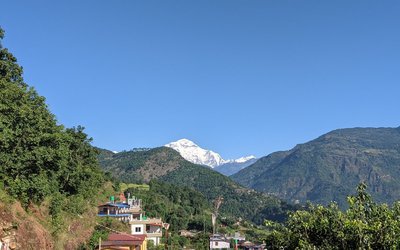For the last many years, everyone has been talking about the need to harness Nepal’s hydro electricity power to export to India and boost Nepal’s economic growth. However, the reality is different.
Instead of exporting power to India, Nepal is now a net importer of electricity from India. With the rivers drying up, Nepal is now importing electricity up to 450 MW from India to reduce load shedding.
As Nepal’s demand for power in internal market is growing and there are only a few big projects in the construction pipeline, Nepal’s reliance on import of electricity from India will continue for some time to come.
As Nepal is now importing electricity worth over 15 billion rupees annually from India, a new report prepared by USAID has revealed that the power trade with India will boost Nepal’s economy.
Released jointly by Michael Gonzales, Deputy Chief of the Mission of U.S. Embassy in Nepal, Dr. Swarnim Wagle, Member, National Planning Commission, and Mala Narendra, Second Secretary, Indian Embassy, an analytical study titled “Economic Benefits from Nepal-India Electricity Trade” has drawn the conclusion that Nepal needs to export its power to boost the economy.
The report analyses the potential of cross-border electricity trade (CBET) between Nepal and India, and its feasibility and impact on the economy, power systems and power infrastructure of both countries.
Carried out by the Integrated Research and Action for Development (IRADe) under the fourth phase of the South Asia Regional Initiative for Energy Integration (SARI/EI) Program, this is a first of its kind study.
SARI/EI is a United States Agency for International Development’s (USAID) program that works to promote cross-border electricity trade to revitalize and accelerate regional economic development in South Asia.
“With accelerated power trade between India and Nepal, Nepal’s gross domestic product could reach NPR 13,100 billion (over $120 billion) in 2045, which is 39 percent more than with existing trading mechanisms. This growth in GDP is driven in part by the three-fold increase from NPR 310 billion in 2030 to NPR 1,069 billion in 2045 in revenue earned from electricity trade,” said Dr. Kirit Parikh, Chairman, IRADe, highlighting the key findings from the report.
Moreover, increased power trade will also fuel Nepal’s per capita electricity demand to jump from the current 139 kWh/year to 1,500 kWh/year by 2045. The report attributes this to increased domestic hydropower production (34.4 Gigawatt in 2045). Per capita electricity demand reflects strongly on the Human Development Index of a country as increased access to electricity is directly linked to better quality of life.
“Asia is the fastest growing region in the world but lacks reliable power infrastructure. With optimum utilization of resources and a coherent regulatory framework in place, better regional integration could be achieved through CBET. The report rightly points out Nepal can gain tremendously from CBET,” said Michael Gonzales, DCM of U.S. Embassy.
For India, the benefits are more in terms of lower electricity system costs due to electricity imports from Nepal. Additionally, the import of hydropower electricity from Nepal will reduce the carbon emissions of the power sector in India as the country’s electricity generation is largely coal-based.
“India is committed to cross-border electricity trade in South Asia. To facilitate this, India’s Ministry of Power in consultation with Ministry of External Affairs recently issued the ‘Guidelines on Cross Border Trade of Electricity,” said Mala Narendra, Second Secretary, Indian Embassy. “The report is a win-win opportunity for both India and Nepal.”
“The report prepared by IRADe is a first-of-its-kind and I hope it will be useful for the Government of Nepal as well as the Planning Commission of Nepal. USAID’s support and assistance is extremely useful for Nepal particularly in expansion of the transmission capacity. Electricity trade and hydropower development can significantly energize Nepal’s economy and can help in the process of industrialization. Both countries stand to gain from India-Nepal electricity trade and going forward, Bangladesh and other South Asian countries also stand to reap benefits from the power trade,” said Dr. Swarnim Wagle, Member, National Planning Commission of Nepal.
Based on the IRADe-System for Analysis of Power Trade and Economic Growth (I-SAPTEG) modeling system, the research uses five models—three power system models and two macro-economic models to capture the impacts of electricity trade on India and Nepal under three scenarios namely accelerated trade, business as usual and delayed capacity addition.
“It has been a painstaking and novel exercise. The power systems of the two countries are linked for different periods i.e. peak and off-peak hours to capture the compatibility for trade in the model. This gave us very different insights. We also linked this to the economic models of each country to capture macro-economic benefits, especially to Nepal,” said Dr. J yoti Parikh of IRADe. “Our aim was to see if Nepal too can follow Bhutan’s example in transforming it."

Keshab Poudel
Poudel is the editor of New Spotlight Magazine.
- ECONOMY: Growth At 3.3
- Apr 16, 2024
- DPM’s SHRESTHA’S CHINA VISIT High Profile, Low Key
- Apr 14, 2024
- Maha Kumbha In Barahkshetra: A Sacred Festival In Sacred Koshi (Kaushiki) River
- Apr 09, 2024
- LOSS AND DAMAGE: Upper Tamakoshi A Case
- Apr 02, 2024
- Helvetas-Nepal’s InElam Promoting Herbal Oil In Sarlahi
- Mar 31, 2024















